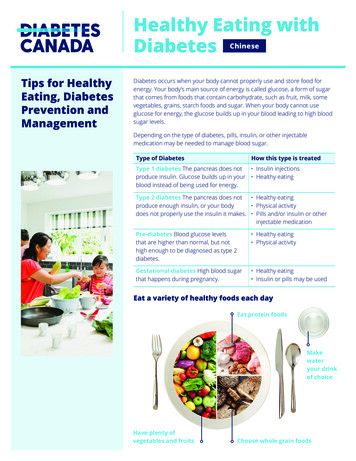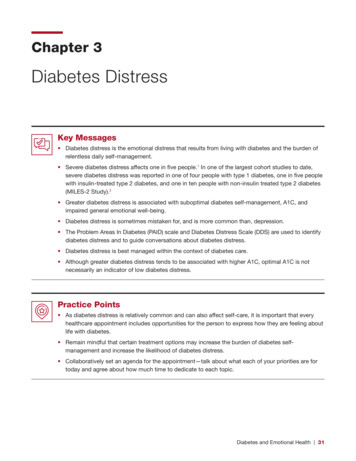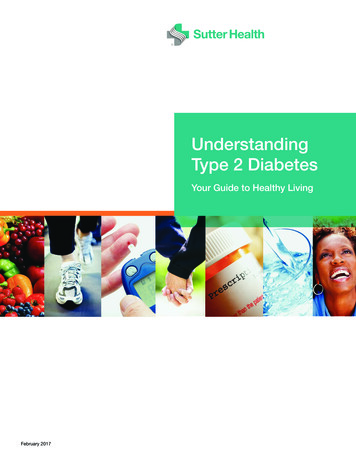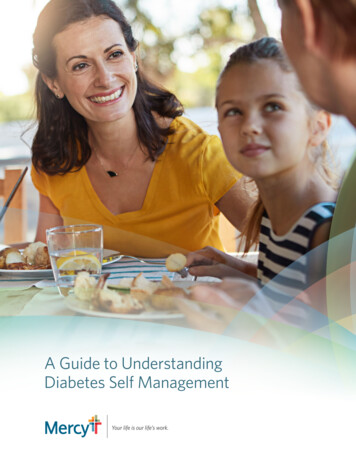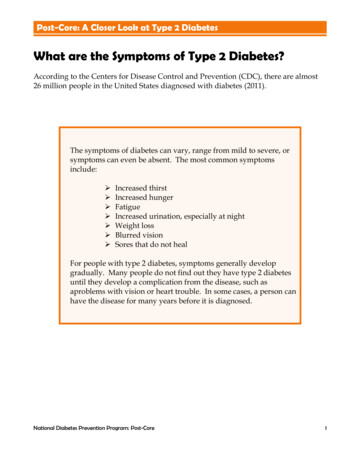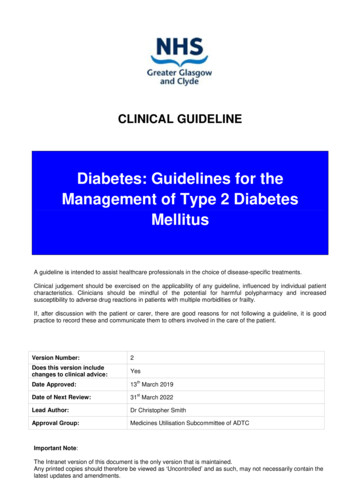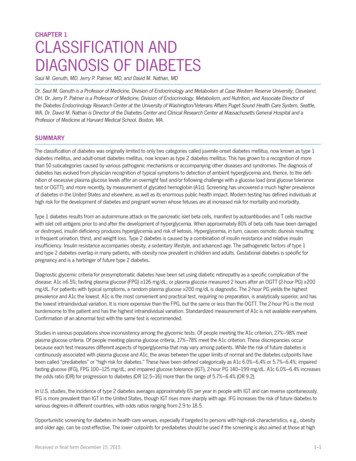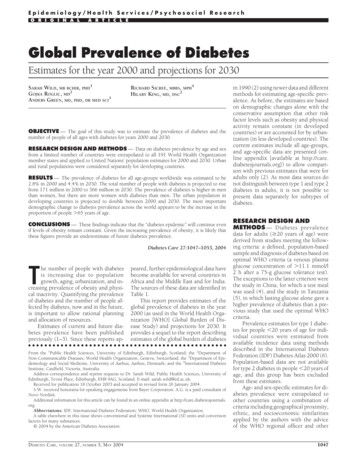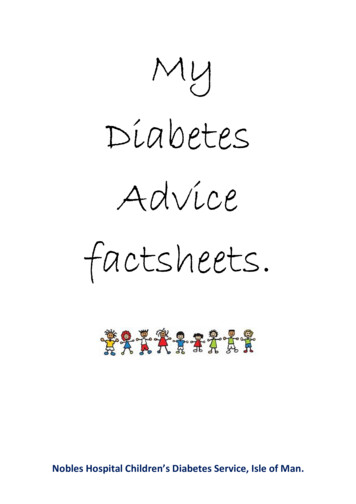
Transcription
MyDiabetesAdvicefactsheets.Nobles Hospital Children’s Diabetes Service, Isle of Man.
Paediatric Diabetes TeamThe Paediatric Diabetes Team predominantly works Monday-Friday 9am to 5pm, and occasionallyprovide additional out of hours cover to either newly diagnosed patients and families or thosestarting on insulin pump therapy.Out of hours telephone support is provided by the Children’s Ward. Tel: 650023.If you think your child may have Diabetic Ketoacidosis (DKA) please take them urgently to theEmergency Department (ED) at Noble’s Hospital.Contact DetailsDr Sadha PunniyakodiConsultant Paediatrician with special interest in Diabetes and EndocrinologyMBBS, MRCPCH, MSc (Paediatric Diabetes)Tel: 01624 650337 (secretary)Dr Vineet VarshneyAssociate Specialist PaediatricsTel: 01624 650000 (Hospital Switchboard)Grant McCallumPaediatric Diabetes Specialist NurseTel: mber 2019Review November 2021
Catherine WallingerPaediatric Diabetes Specialist NurseTel: mSarah Surgeon BSC MSC RDPaediatric DieticianTel: 650865Maura KellySecretary to Dr PunniyakodiTel: 650337November 2019Review November 2021
Hypoglycaemia (hypo)What is a ‘hypo’The full name for a hypo is hypoglycaemia. It’s when your blood glucose level(also called blood sugar) is too low, usually below 4mmol/l in people that haveDiabetes. A hypo can happen quickly, so it’s important you know what the signsare and what to do if your child has a hypo.What causes a hypo? too much insulin has been taken unplanned or strenuous exercise a delayed or missed meal or snack not enough carbohydrate food sometimes no obvious cause.Signs and symptoms of a hypoEveryone has different symptoms, but the most common symptoms of a hypoare: trembling and feeling shakysweatingbeing anxious or irritablegoing palepalpitations and a fast pulselips feeling tinglyblurred sightbeing hungryfeeling tearfultirednesshaving a headachelack of concentration.
You must do something as soon as you notice symptoms of ahypo, or if a blood test has shown your blood glucose (alsocalled blood sugar) levels are too low.Treating a hypoTreat the hypo immediately. You can do this by eating or drinking a fast-actingcarbohydrate:Children up to 5 years 5gChildren 5-10 years 5-10gChildren over 10 years 10-15gIf you’re feeling too drowsy or confused to eat or drink, ask someone to helpyou. If you don’t act quickly, it could get much worse and you could alsobecome unconscious or have a fit. This is called a severe hypo, and you wouldneed somebody to help to treat it (see ‘what to do when someone is having asevere hypo’).Examples of hypo treatments: glucose or dextrose tablets (4 - 5g per tablet)jelly babies (4 - 5g per jelly baby)a small glass of a sugary (non-diet) drink 15ga small carton 150mls of pure fruit juice 15g1 tube of a glucose gel such as GlucoGel (10g per tube)Which hypo treatment you choose is up to you? The type and amount dependson what works best for you. It might depend on your taste, or how easy it is tostore or carry around. You can get things like glucose gel, glucose tablets anddextrose tablets on prescription. Talk to your diabetes team about this. Theycan give you advice about how much to take and which treatment to choose.
If you’re not sure how much carbohydrate is in a product, check the food label.It's important to check this often, as ingredients can change.Re-test your blood glucose level after 15 minutes. If the level is still below4mmol/l then you will need to treat the hypo again with a further 5g to 15gof a fast-acting carbohydrate and re-test after a further 10 - 15 minutes.After having a hypoAfter a hypo, you may need to eat or drink a bit more especially if you are goingto be very active. This is to stop your blood glucose levels going down again.Try to eat 5g to 10g of a slower-acting carbohydrate. This could be a: Cereal bar piece of fruit biscuitOr it could be your next meal, if it’s due. If you are on an insulin pump you may not need to have this additionalsnack.What to do when someone is having asevere hypoIt’s important that your family and friends know what to do if you have a severehypo and become unconscious. They shouldn’t try to give you any food or drinkbecause you won’t be able to swallow. They will need to help you very quickly.They need to: put you into the recovery position (on your side, with your head tilted back andknees bent) give you a glucagon injection – if there is one available and someone knowshow to use it
call an ambulance (999).It can be a good idea to record your hypos, to see if there are any trends orpatterns. Knowing this may help your healthcare team find the best diabetestreatment for you.Hypos at nightLow blood glucose levels can happen at night, and some people don’t alwaysnotice the symptoms and wake up straight away. This means that your bloodglucose levels may drop further and the hypo may get more severe. If the hypodoesn’t wake you up, you may only realise that you've had one if you feel verytired, have wet the bed or have a headache the next morning.If you think you might be having hypos at night, check your blood glucose levelsat bedtime (22:00 – 23:00hrs) then test again at 03:00 - 04:00hrs. If your bloodglucose levels are dropping during this time then you may need to change yourbasal insulin dose. If you are using a Libre or Dexcom CGM then looking at thedaily information or Ambulatory Glucose Profile (AGP) will highlight anyepisodes of hypoglycaemia.Speak to the Diabetes team for any support with changing insulin doses ormanaging hypos.OnceAdapted from Diabetes UK ‘Having a Hypo’Catherine Wallinger & Grant McCallum. 11/2019Review 11/2022
Adjusting Insulin Doses to Maintain Good ControlIn order to keep Blood Glucose (BG) levels within target while your child grows,you may need to change insulin doses in-between clinic visits. These tips willhelp you to know what to do and when:1. Ideal BG levels are 4-7mmols/L before meals and 5-9mmols/L 2 hours after.2. Keep a record book (BG diary) and try to fill it in at least twice a week with all the BGlevels from your child’s meter. If using Continuous Glucose Monitoring (CGM) orLibre (Flash GM) aim to review your child’s data at least weekly.3. Look at the BG readings in the record book or computer data every week with yourchild and compare their BG’s to their target range. Discuss any adjustments that maybe required that way your child will learn with you about how to change doses.4. Always give your child’s usual correction dose if levels are more than 7.0mmol/Lbefore a meal. A correction may also be needed with a snack (follow advice fromyour Insulin pump or Bolus advisor BG meter).5. Adjusting your Insulin to carbohydrate Ratios (ICR’s) - Look for patterns of high BGlevels and increase insulin doses if BG levels are high (more than 7.0 mmol/L beforemeals ) 4 days or more a week. If your child has high BG levels before a particularmeal which is not related to snacking between meals, increase the insulin dose forthe meal eaten BEFORE the levels became high.This also applies If your child has high BG levels before bed (target before bed 6 7mmol/L) by increasing the insulin to carb ratio for their evening meal in the sameway.e.g if your child’s level is high at lunchtime increase their breakfast Insulin toCarbohydrate Ratio (ICR) by 1g if 1:10g or less and by 2g if more than 1:10gi.e : If your child’s breakfast ICR is 1:10g, then consider changing to 1:9gif 1:15g change to 1:13g6. If your child has high BG levels on waking in the mornings (more than 6 mmol/L for4 days or more in a week) and these are not because of high levels before bed,increase the Tresiba or pump basal rates by 10% (see guide on next page)G McCallum & C Wallinger 10/2019Review 10/2022
How to increase basal rates if on a pump or long acting insulinOn a pump If not using CGM or FGM Check BG levels late pm, around 0300 and beforebreakfast.If your BG rises overnight and is higher on waking than at bedtime withoutevidence of overnight hypo consider a basal rate increase 2 hours before thepoint where your BG starts to rise (Contact your Diabetes nurse if unsure how todo this)How to increase Tresiba, Levemir or Lantus Check BG levels late pm, around 0300 and before breakfast. If your BG is higher on waking than at bedtime without evidence of overnighthypo consider increasing your child’s Tresiba, Levemir or Lantus If your child is on less than 5units increase by 0.5 unit each time (you will need tobe using a 0.5 unit pen)If your child has 5 – 10 units increase by 1 unit at a timeIf your child has 10 - 20 units increase by 2 units at a timeIf your child is on more than 20 units increase by 10% i.e 30 units add 3 units, 50units add 5 unitsWait 3 days before further increasesIf you are unsure where to make changes please don’t hesitate to call the DiabetesNurses.G McCallum & C Wallinger 10/2019Review 10/2022
Recommendations for avoiding hypoglycemia inphysically active young people with type 1 diabetes Begin session with blood glucose levels within acceptable range (notvery high or below 4mmols), and without high ketone levels. Measureglucose before start of exercise Always bring snacks Increase the intensity and/or the duration of the exercise progressively In the few hours before the exercise, take a slowly absorbingcarbohydrate snack In the case of unplanned physical activity reduce the insulin dose duringand after intense muscular activity Do not inject insulin at a site that will be heavily involved in muscularactivity When physical activity is planned at a time of peak insulin action(following a bolus/extended bolus), a reduction of the insulin doseshould be made (see chart) If the activity is prolonged (long distance cycling, long distancerunning/cross country), add glucose sweetened water or carbohydratesbefore, during and after the exercise Measure the blood glucose value before bedtime on the evening aftermajor physical activity and make sure to add extra carbohydrates and/orreduce long-acting/basal dose to reduce the risk of nocturnalhypoglycemiaISPAD – guidelines 2018Catherine Wallinger and Grant McCallum 11/2019Review 11/2022
Observe and record every change in insulin basal and bolus rate, andevery change you have made to snacks/meals during and after sports tofind out what works best for you Make the people accompanying you aware of the procedures andtreatment of severe hypoglycemia If CGM: Check alert levels of decreasing values or low glucose limit andadd a follower to increase safetyAbbreviation: CGM, continuous glucose monitoring.Bolus insulin adjustments for post meal exerciseMeal before exerciseContinuous, moderate tovigorous intensity aerobicactivitiesActivities lasting Activities lasting Meal after30-45 minutes 45 minutesexercise25%-50% bolusreduction50%-75% bolusreductionUp to 50%bolusreduction25% bolusreduction50% bolusreductionUp to 50%bolusreductione.g, jogging/running,moderate intensityswimming, bicycling, crosscountry, aerobic playMixed aerobic and anaerobicburst activitiese.g, hopping, skipping,dance, gymnastics, tag,dodgeball, field and teamsports, individualracquet sports, etc.ISPAD – guidelines 2018Catherine Wallinger and Grant McCallum 11/2019Review 11/2022
ssociation of Children’s Diabetes CliniciansPatient Advice for Management of Type 1Diabetes Mellitus during illness in children andyoung people under 18 years (Sick Day Rules)Note to parents and patients: This guideline should be discussed with your Paediatric Diabetesteam before you use it as in some cases they may have to adapt it for your individual useSickness is an unavoidable part of everyday life. The body’s natural response to illness resultsin higher blood glucose levels due to the release of stress hormones. During illness, you willneed frequent blood glucose monitoring and often more insulin than usual.What are ketones?Ketones are acids which can make you feel very sick. They are produced when body is notgetting enough food (glucose) or your body is not able to use glucose due to lack of insulin. Ifyou do not get rid of ketones, you can become dehydrated and eventually develop Diabeticketoacidosis. Check for ketones whenever you are ill, regardless of your glucose levels asyou can have raised ketones with normal glucose levels i.e. starvation ketones withgastroenteritisSick day rules1. Never stop the insulin. Even if you are eating less than normal, your body needsinsulin to use glucose and to get rid of ketones.2. Check your blood glucoses more frequently eg every 2 hours including throughout thenight.3. Check for blood ketones. Give additional fast acting insulin every 2 hours if bloodglucose is above target. (See Table )4. If ketones are present when blood glucose is low, they are called 'starvation ketonesand respond to drinking extra fluids containing sugar. Monitor blood glucose veryclosely and extra insulin may be required when blood glucose starts rising.5. Keep well hydrated by drinking plenty of fluids.a. Water, or sugar-free fluids are probably most appropriate in the majority of caseswhere blood glucose levels are normal or highb. If blood glucose levels are low, drinks containing sugar are required, or eatcarbohydrates if possible.c. Avoid carbonated drinks if possible6. Inform the diabetes team early to seek adviceUsing Sick day rules for pump patients1. Same principles apply for pump patients with regards to glucose testing and fluid intake.1Version 4, Feb 2018Review 2021Authors: SM Ng, A Soni, JC Agwu, JA Edge, JH Drew, C Moudiotis, NP Wright, M Kershaw, MCGardner, L Connellan, W Assam
ssociation of Children’s Diabetes Clinicians2. In addition, even if unwell and blood glucoses are high, standard checks on the pumpshould be made for occlusions, disconnection and battery failures.3. Give correction doses through the pump if blood ketone levels are less than 0.6mmol/l. Ifone correction dose given via the pump has no effect in 1 hour, repeat the correctiondose with insulin pen.4. If blood ketones are higher than 0.6mmol/l, give additional fast acting insulin using aninsulin pen.5. When blood glucose levels are rising in an unwell child needing frequent additionalinsulin doses, think about using higher temporary basal rates.Negative ketones 0.6mmol.l(Blood)Take a correction dose (CD) tocorrect high blood glucose(BG) in addition to normalbolus for carbohydrates eatenSmall to moderate ketones0.6 – 1.5mmol.l(Blood)Give Then: Re -check BG andketones in two hoursThen: If your BG is going down that isa good sign but monitor closelythroughout the day.If BG is increasing but ketonesless than 0.6 mmol/l: Take another correctiondose using a penIf ketones 0.5 – 1.5mmol/l,follow orange column adviceIf ketones 1.5mmol/l, followthe red column advice10% of your total dailydose (TDD) of insulin asadditional fast actinginsulinOR0.1 units/kg body weight asadditional fast actinginsulinMonitor fluid intake andensure you are drinkingenough fluids to keep wellhydratedRe-check BG and ketonesin two hours (See below)Moderate to large ketones 1.5mmol.l(Blood)Give Then: 20% of your total daily dose(TDD) of insulin as additionalfast acting insulin.OR0.2 units/kg body weight asadditional fast acting insulinMonitor fluid intake andensure you are drinkingenough fluids to keep wellhydratedRe-check BG & ketones intwo hours (see below)If ketones negative follow greencolumn adviceIf ketones negative follow greencolumn adviceIf BG is increasing but ketones still0.6 – 1.5mmol/l: Continue to give 10% of TDDor 0.1 Units/kg as additionalfast acting insulin every 2hours using a pen Give usual boluses for food Re-check BG and ketonesevery 2 hours even through thenight!If BG is increasing but ketones havereduced to 0.6 – 1.5mmol/l, followorange column adviceIf ketones increase to 1.5mmol.l,follow the red column adviceIf ketones are still 1.5mmol.l: Give another 20% TDD or0.2units/kg as additional fastacting insulin every 2 hoursusing a pen Give usual boluses for food Once vomiting with highketones, go to Accident andEmergency2Version 4, Feb 2018Review 2021Authors: SM Ng, A Soni, JC Agwu, JA Edge, JH Drew, C Moudiotis, NP Wright, M Kershaw, MCGardner, L Connellan, W Assam
Checking basal rates on a pumpBasal rates should be checked every few months especially when seeing an increase in BloodGlucose (GB) levels, school holiday provide a good opportunity to do this.This is required to ensure your child’s programmed basal rates are meeting their body’s requirementfor the background supply of insulin. The basal insulin dose will need to be increased as they growand develop. The teenage growth spurt is a particularly important time. Testing your child’s basal rate involves fasting or having no Carbohydrates (CHO) for a periodof time or, if this is not possible, delay eating for as long as possible.If their basal rate is right for them, their blood glucose level should be kept within theirtargets.It is important to consider when they last had a bolus (insulin for food or correction) and atesomething, and what it was they ate, as these factors could still be affecting their bloodglucose into the basal test period.It is not a good idea to check basal rates if your child is ill or has been doing a lot of exercise.Don’t try to do the whole day at once. Getting the overnight period right first is usuallya good idea, then breakfast until lunch, lunch until evening meal, and lastly eveningmeal till bedtimeGeneral rules when checking your child’s basal rate: Have your last meal at least two hours before starting to fast and avoid foods which take a longtime to digest (meals high in fat and protein content) as they can continue to affect blood glucoselevels for several hours after eating. Omit the next meal or delay it for as long as possible. Give a normal insulin bolus with the last meal before the fasting starts. Your child should not eat any snacks during fast period (they can drink water and if required canhave a carb free snack). Check blood glucose level every one to two hours during the fast. If a hypo occurs (blood glucose under 4.0 mmol/L) treat and abandon test. If hyperglycaemia occurs (blood glucose over 14 mmol/L) treat and abandon test. Once complete, you can assess the results and change your child’s basal rates if required.Checking the overnight basal rate If blood glucose drops below 4.0 mmol/L or rises above 14 mmol/L during the fast, abandonthe fast for that day and treat the low or high blood glucose.Adapted from Leeds Insulin Pump Work Book for Children and Young PeopleBy Grant McCallum and Catherine Wallinger 11/2019 review 11/2022
If you see a rise or fall in BG you will need to change the basal rate. Look at the profile at thepoint where the BG started to go high or low, and go back two hours and increase ordecrease the basal rate at that point.In general it is recommended to increase or decrease by approx. 0.025 – 0.1units per hour ata time depending on the child’s age and sensitivity to insulin (Omnipod’s smallest incrementis 0.05units per hour).Always repeat the testing on another day to see if it is now correct.StepsProcedure No bedtime snackTest blood glucose every 2-3 hours, including overnightMiss breakfast and morning snack, or delay as long as possibleAbandon test if under 4.0 mmol/l or over 14 mmol/lIf blood glucose stays in target range: no changeIf blood glucose rises or falls more than 2 mmol/l, increase/decrease basal rate over therelevant time periodAdjust the basal rate (0.025 - 0.1 units per hour depending on age and sensitivity beginning2 hours before the effect is required)The effect of the adjustment should be re-checked over the next few daysThe use of continuous glucose monitoring may be consideredIn small children only 1 meal can be omitted at a time, so you may need to checkthe basal rates over more days to get all correct*When the blood glucose does not remain stable within /- 2 mmol/l, adjustments of the basal rateare recommended.*Some young people need more insulin with breakfast due to the effects of the dawn phenomenon.This is a rise in BG which occurs in the hours before breakfast due to increased hormonal activity andis most noticeable during puberty.Adapted from Leeds Insulin Pump Work Book for Children and Young PeopleBy Grant McCallum and Catherine Wallinger 11/2019 review 11/2022
What to do in the Event of an Insulin Pump FailureInsulin pumps are usually very reliable medical devices but there is always apossibility that you may experience a pump failure at some time. To avoidunnecessary stress we would advise that you make a plan for such an event. As back-up it is advisable to always have the items listed below a) an in date supply of Novorapid (Fast acting insulin) and Levemir (Longlasting/basal insulin)b) 2 x Novopen insulin devices (if using insulin cartridges) Keep a note of your Insulin to Carbohydrate Ratios (ICR’s) and InsulinSensitivity Factor also known as your Correction Factor (ISF) from yourpump and update these each time you make an adjustment In the event of a pump failure use your current Insulin to CarbohydrateRatios and Insulin Sensitivity Factor to work out meal time andcorrection insulin doses which you can give using Novorapid insulin viaan insulin penWritten by Grant McCallum and Catherine Wallinger 02/2020Review 02/2023
Keep a note of your total daily basal insulin dose from your pump andupdate this each time you make an adjustment.For Omnipod users you can find this information by going into your pumpmenu via “settings” then “Basal Programs” then selecting whichever basalprogram you are using then “View”. The daily basal amount will bedisplayed at the bottom of the screenFor Medtronic Users this information can be found in your pump via theMenu then select “History” then “Summary” then select the 14 day option,the basal amount will be displayed below the TDD (total Daily Dose)In the event of a pump failure if you are likely to be off your pump for morethan 24 hours give the Total daily basal pump amount as your basal/longlasting insulin (Levemir) using an insulin peni.e. if you are using 22units of basal insulin via your pump give yourself 22unitsof Levemir insulin you have as backupIf you are likely to be off your pump for less than 24 hours you can giveNovorapid every 4 hours to cover carbohydrate intake and to correct highblood glucose readings if required using your ICR’s and ISF from your pumpContact your pump supplier for a replacement as soon as possibleOmnipod Pump users: 0800 011 6132Medtronic Pump users: 01923 205167Written by Grant McCallum and Catherine Wallinger 02/2020Review 02/2023
4. Always give your child's usual correction dose if levels are more than 7.0mmol/L before a meal. A correction may also be needed with a snack (follow advice from your Insulin pump or Bolus advisor BG meter). 5. Adjusting your Insulin to carbohydrate Ratios (ICR's) - Look for patterns of high BG

